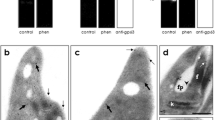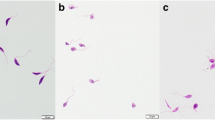Abstract
The antiproliferative effect of julocrotine, an alkaloid isolated from Croton pullei var. glabrior (Euphorbiaceae), was studied in the macrophage amastigote and promastigote stages of the protozoan Leishmania (L.) amazonensis, which causes cutaneous leishmaniasis in the New World. Julocrotine showed a dose-dependent effect against the amastigote and promastigote forms, where 79 μM julocrotine inhibited promastigote growth by 54%, with an IC50 of 67 μM. To analyze the antiamastigote activity of the drug, murine peritoneal macrophages infected with L. amazonensis promastigotes were treated with different concentrations of julocrotine. An 80% inhibition of amastigote development was observed using 79 μM julocrotine for 72 h, with an IC50 of 19.8 μM. In addition, ultrastructural observation of the parasites showed a significant reduction in the number of amastigotes in the parasitophorous vacuoles and morphological changes in promastigotes, such as swelling of the mitochondrion, chromatin condensation, presence of membranous structures near the Golgi complex, and some vesicle bodies in the flagellar pocket. A colorimetric assay (MTT), which measures cytotoxic metabolic activity, showed that macrophages maintain their viability after treatment with the drug. These results suggest that julocrotine effectively inhibits the growth of parasites and does not have any cytototoxic effects on the host cell.







Similar content being viewed by others
References
Ashutosh SS, Goyal N (2007) Molecular mechanisms of antimony resistance in Leishmania. J Med Microbiol 56(PT 2):143–153
Barbosa PS, Abreu AS, Batista EF, Guilhon GMSP, Muller AH, Arruda MSP, Santos LS, Arruda AC, Secco RS (2007) Glutarimide alkaloids and terpenoids from Croton pullei var. glabrior Lanj. Biochem Syst Ecol 35:887–890
Block S, Gerkens P, Peulen O, Jolois O, Mingeot-Leclercq MP, De Pauw-Gillet MC, Quetin-Leclercq J (2005) Induction of apoptosis in human promyelocytic leukemia cells by a natural trachylobane diterpene. Anticancer Res 25:363–368
Brenzan MA, Nakamura CV, Filho BPD, Ueda-Nakamura T, Young MC, Cortez DAG (2007) Antileishmanial activity of crude extract and coumarin from Calophyllum brasiliense leaves against Leishmania amazonensis. Parasitol Res 101:715–722
Chen M, Christensen SB, Blom J, Lemmich E, Nadelmann L, Fich K, Theander TG, Kharazam A (1993) Licochalcone A, a novel antiparasitic agent with potent activity against human pathogenic protozoan species of Leishmania. Antimicrob Agents Chemother 37:2550–2556
Croft SL, Coombs GH (2003) Leishmaniasis—current chemotherapy and recent advances in the search for novel drugs. Trends Parasitol 19:502–508
Croft SL, Sundar S, Fairlamb AH (2006) Drug resistance in leishmaniasis. Clin Microbiol Rev 19:111–126
Delorenzi JC, Attias M, Gattass CR, Andrade M, Rezende C, Pinto AC, Henriques A, Bou-Habib D, Saraiva EM (2001) Antileishmanial activity of an indole alkaloid from Peshiera australis. Antimicrob Agents Chemother 45:1349–1354
González P, Marín C, Rodríguez-González I, Hitos AB, Rosales MJ, Reina M, Díaz JG, González-Coloma A, Sánchez-Moreno M (2005) In vitro activity of C20-diterpeneoid alkaloid derivatives in promastigotes and intracellular amastigotes of Leishmania infantum. Intern J Antimicr Agents 25:136–141
Lainson R, Shaw JJ (2005) Leishmaniasis in the New Word. In: Collier L, Balows A, Sussman M (eds) Topley & Wilson’s Microbiology and Microbial Infections, vol 5, Parasitology, 10th edn. Arnold, London, pp 313–349
Mishra BB, Kale RR, Singh RK, Tiwari VK (2009) Alkaloids: future prospective to combat leishmaniasis. Fitoterapia 80:81–90
Morales A, Pérez P, Mendoza R, Compagnone R, Suarez AI, Arvelo F, Ramírez JL, Galindo-Castro I (2005) Cytotoxic and proapoptotic activity of ent-16beta-17alpha- dihydroxykaurane on human mammary carcinoma cell line MCF-7. Cancer Lett 218:109–116
Moreira RYO, Brasil DSB, Alves CN, Guilhon GMSP, Santos LS, Arruda MSP, Müller AH, Barbosa PS, Abreu AS, Silva EO, Rumjanek VM, Souza J Jr, da Silva ABF, Santos RHA (2008) Crystal structure and theoretical calculations of Julocrotine, a natural product with antileishmanial activity. Int J Quant Chem 108:513–520
Paris C, Loiseau PM, Bories C, Bréard J (2004) Miltefosine induces apoptosis-like death in Leishmania donovani promastigotes. Antimicrob Agents Chemother 48:852–859
Rodrigues JCF, Attias M, Rodriguez C, Urbina JA, de Souza W (2002) Ultrastructural and biochemical alterations induced by 22, 26-Azasterol, a delta 24(25)-sterol methyltransferase inhibitor, on promastigote and amastigote forms of Leishmania amazonensis. Antimicrob Agents Chemother 46:487–499
Rodrigues JCF, Concepcion JL, Rodrigues C, Caldera A, Urbina JA, de Souza W (2008) In vitro activities of ER-119884 and E570, two potent squalene synthase inhibitors, against Leishmania amazonensis: antiproliferative, biochemical, and ultrastructural effects. Antimicrob Agents Chemother 52:4098–4114
Rosa MS, Mendonça-Filho RR, Bizzo HR, Rodrigues IA, Soares RM, Souto-Padrón T, Alviano CS, Lopes AH (2003) Antileishmanial activity of a linalol-rich essential oil from Croton cajucara. Antimicrob Agents Chemother 47:1895–1901
Singh S, Sivakumar R (2004) Challenges and new discoveries in the treatment of leishmaniasis. J Infect Chemother 10:307–315
Suárez AI, Blanco Z, Compagnone RS, Salazar-Bookaman MM, Zapata V, Alvarado C (2006) Anti-inflammatory activity of Croton cuneatus aqueous extract. J Ethnopharmacol 105:99–101
Tiuman TS, Ueda-Nakamura T, Cortez DAG, Dias Filho BP, Morgado-Díaz JA, de Souza W, Nakamura CV (2005) Antileishmanial activity of parthenolide, a sesquiterpene lactone isolated from Tanacetum parthenium. Antimicrob Agents Chemother 49:176–182
Torres-Santos EC, Moreira DL, Kaplan MAC, Meirelles MN, Rossi-Bergmann B (1999) Selective effect of 2′, 6′-dihdroxy-4′-methoxychalcone isolated from Piper aduncum on Leishmania amazonensis. Antimicrob Agents Chemother 43:1234–1241
Vannier-Santos MA, Urbina JA, Martiny A, Neves A, de Souza W (1995) Alterations induced by the antifungal compounds ketoconazole and terbinafine in Leishmania. J Eukaryot Microbiol 42:337–346
World Health Organization (2009) Leishmaniasis: the global trend. http://www.who. int/neglected_diseases/integrated_media_leishmaniasis/en/index.html. Accessed 17 May 2009
Acknowledgments
This work was supported by Conselho Nacional de Desenvolvimento Científico e Tecnológico (CNPq), Secretaria de Desenvolvimento Científico e Tecnológico (SEDETEC)/Fundação de Amparo à Pesquisa do Estado do Pará (FAPESPA)/Universidade Federal do Pará (UFPA)/Fundação de Amparo e Desenvolvimento da Pesquisa (FADESP), and Programa de Capacitação Acadêmica (PROCAD-CAPES). We are grateful to Fernando Silveira for providing the promastigote forms of L. (L.) amazonensis and to Renato Augusto DaMatta for his critical review of the manuscript. The experiments performed in this work comply with current Brazilian laws.
Author information
Authors and Affiliations
Corresponding author
Rights and permissions
About this article
Cite this article
Guimarães, L.R.C., Rodrigues, A.P.D., Marinho, P.S.B. et al. Activity of the julocrotine, a glutarimide alkaloid from Croton pullei var. glabrior, on Leishmania (L.) amazonensis . Parasitol Res 107, 1075–1081 (2010). https://doi.org/10.1007/s00436-010-1973-0
Received:
Accepted:
Published:
Issue Date:
DOI: https://doi.org/10.1007/s00436-010-1973-0




